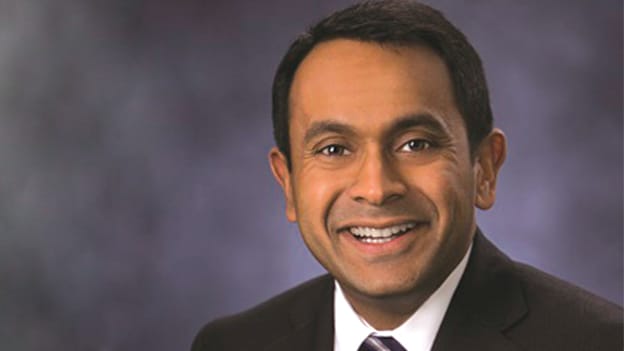Leading from the edges: WTW's Ravin Jesuthasan

Curiosity and the drive to learn are going to be the most critical skills as the HR profession is on the cusp of entering a demanding Fourth Industrial Revolution. As the traditional role of a Chief Human Resource Officer undergoes a transformation and turns into a Chief People Officer, with the convergence of technology, machines and humans, workplaces will soon hire for Chief People and Machine Officer and Chief of Work, shared Ravin Jesuthasan, Author and Managing Director, Willis Towers Watson, in an exclusive interaction with People Matters.
Here are some insights from Ravin Jesuthasan about the new-age skills that will enable CHROs to become future-ready and how leadership and culture can be redefined in order to “lead from the edges” and empower organizations to brave the winds of change in a dynamically evolving world of work.
Let's first set the context for the Fourth Industrial Revolution. There is a lot happening demographically, societally, economically, and technologically in the landscape of people and work. How are these factors affecting the way organizations currently look at talent or need to look at talent?
What’s really fascinating is that a number of years ago, we asked this question when Klaus Schwab wrote his book on the Fourth Industrial Revolution. We questioned ourselves whether this is a fundamental change in work or is it just technology continuing to do what it always does - making things more efficient, raising the speed quotient, etc. But what we’re seeing is actually something fundamentally different.
Artificial Intelligence has been with us since the late fifties but we never had the enabling infrastructure that we have today. The convergence of multiple technologies such as cloud-based computing, transformations in mobile, the emergence of 5G, rapid proliferation of low-cost sensors to generate data, and the increasing speed and falling cost of graphic processing units, is empowering technologists, business leaders, and people managers to realize the true potential of AI and other technologies.
The other key variable is the democratization of work which is the ability to distribute work anywhere in the world and tap into talent at anytime without the frictional cost of hiring a person into a job. The convergence of these factors is presenting organizations with significant challenges in terms of thinking about how to get work done, in the best possible way. At the same time, these factors are also creating options like we’ve never seen before. Today, as business leaders, we have at least eight options for getting work done from employees to independent contractors to gig workers to outsourcing and alliances to tapping into volunteers for crowd-sourcing innovation or promoting brands on social media to the more intriguing options of robotics and AI.
However, these choices also pose some real opportunities for HR to rethink its role. Increasingly this profession needs to shift from being a steward of employment to being a steward of work.
What do you see as the biggest obstacle for organizations, especially for those that are trying to transition into the digital world?
The biggest obstacle is legacy - legacy of culture, mindset, leadership routines, behaviors, toolset, etc. That is the biggest challenge. There are many things that we’re seeing that organizations are doing well in order to transform themselves. At the heart of this transformation is that an increasing number of these large enterprises are embracing agile and a growth mindset to counteract this legacy. They are starting to transform their core DNA.
Can you share some insights about how organizations are shifting away from the legacy mindset to embrace agile? What are some of the approaches for CEOs and CHROs?
Most legacy cultures are predicated on an avoidance of risk and failure. Risks are unavoidable. However, the key to getting out of the legacy mindset and embracing agile is to understand that there is even more risk involved in not doing anything new and different! The status-quo is not here to stay. Change or Die used to be the mantra. Now, the mantra is Change Faster or Die Faster. It is imperative that organizations adopt a mindset of continuous experimentation. In the words of Nelson Mandela; “I never lose, I either win or learn”.
As organizations operate more distributed business models, leaders will need to lead from the edge, adopt the right technologies, drive a new vision of organizational culture and shape innovative people strategies for the future of work
There seems to be a lot of ambiguity in this journey of transformation, especially in terms of becoming agile. Is it a structured approach or do you try and experiment and draw notes?
The thing about a concept like agility is, because it has become so widespread, it ends up taking on different flavors--there is no value judgement there. It may appear random but in fact, it is highly structured and strategically driven towards a specific outcome.
If you look at the origins of agile, from a software development perspective, it's all about quick series of sprints, rapid iterations, co-creation, etc. It gets you better results much faster. However, it does require people to engage continuously and be all-in at all times. This is opposed to a traditional waterfall approach where there is a lot of analysis, powerpoint presentations, and ultimately one person makes the decision of signing off on a particular project.
Basically, the journey of transformation is formally structured in its approach and agile in its content. Now, perhaps you could shed some light on the context of agile and what are the implications of that context when you look at the traditional role that the CHRO used to play in an organization, and is still playing to a large extent, especially in Asia? What are the major shifts that the CHRO role is going to undertake?
The CHRO role is going to change pretty dramatically. We recently worked and completed a major research project with the World Economic Forum in collaboration with Unilever and Saudi Aramco called HR4.0¹. In the study we articulated six imperatives for the HR function:
Developing new leadership capabilities for the 4th Industrial Revolution: As organizations operate more distributed business models, leaders will need to lead from the edge, adopt the right technologies, drive a new vision of organizational culture, and shape innovative people strategies for the future of work.
Managing the integration of technology in the workplace: The way work gets done is changing. A growing area of responsibility for HR is to partner with CEOs and C-suite leaders to achieve the optimal combination of human workforce and automation to ensure a positive impact on the future of work.
Enhancing the employee experience: The increasing complexity of the workforce and the use of technology is calling for a change in the way work is experienced. HR plays a vital role in defining, measuring, and enabling the meaningful employee experience in the 4IR.
Building an agile and personalized learning culture: HR plays a leading role in fostering a culture of lifelong learning in the context of declining demand for certain skills, the emergence of new ones and the requirement for talent to continuously learn, unlearn, and relearn.
Establishing Metrics for Valuing Human Capital: The mutually beneficial relationship between the workforce, organizations and society make it essential for HR to create a compelling case for establishing viable and scalable measures of human capital as a key performance driver and continuously demonstrate the impact of its work on business performance.
Embedding Diversity and Inclusion: Changing social, economic and political forces bring an opportunity for organizations to profoundly advance inclusion and diversity. HR plays a pivotal role in promoting a sense of purpose and belonging in the workforce, and equality and prosperity for the communities and regions in which they operate.
Now, let's think about the shift towards becoming the steward of work from having been the steward of employment, and the implication of these six pillars. How ready are the current leaders to make this shift? What kind of transformational skills will be required to deliver this promise?
Business acumen is one of the top skills. Knowing what you’re solving for and recognizing that what we are solving for now, is dramatically different from the problem statements of the past. Having the intellectual curiosity to want to go beyond the work that you do is important. Have the curiosity to look around corners and see what’s coming next. One of the emerging roles that I am intrigued by, is this idea of having a dedicated person to oversee new and emerging digital technologies within HR. The speed of change is so great that you need someone dedicated to just see what’s coming next. You need someone to sense the market.
HR plays a pivotal role in promoting a sense of purpose and belonging in the workforce, and equality and prosperity for the communities and regions in which they operate
You talked about the transition of the CHRO role from Chief People Officer to Chief People and Machines Officer. It really requires an in-depth understanding of a field that was never required previously, for example, technology and business. In your experience, what are some of the things that you've seen successful CHROs do in order to make this transition?
The old tried-and-true rotations still work. Having HR rotate through different parts of the business has had some success. Moreover, taking a much more collaborative approach with the rest of the C-suite is critical today. It is not just about HR departments working independently by themselves anymore. We're seeing HR and business operations collaborate a lot more today. It is intriguing to see that many CHROs are stepping up and helping their organizations lead with the work as they implement automation and technology.
The organizations who lead with technology invariably almost always fail because there is often a lot of breakage. A typical outcome is one where companies look to substitute talent in jobs versus seeing the nuances of where the technology might substitute some tasks, augment others or create new human work. And, this is where the CHRO is actually leading the work. They are the ones asking the questions such as, ‘let’s understand what the cultural implications are, what are the capability, cost, and risk implications and then let’s figure out the optimal role of technology.’ More and more organizations are recognizing the need to lead with the work and progressive CHROs are actually pushing the envelope here.
It is time to blow up the HR function's traditional model of Centers of Excellence and move towards implementing the principles of how we work in an agile environment
If we take it forward to the structure of an HR team that will be able to do justice to the aforementioned imperatives, what are some of the traditional roles that will probably go away? And what are some of the new roles that you think will come in? What would be a good way to transform the traditional verticalized structure in a way to break the silos and prepare for the future of work?
It is time to blow up the HR function’s traditional model of Centers of Excellence and move towards implementing the principles of how we work in an agile environment. Organizing the work of the function around the work and employee experience will be increasingly critical. Having diverse perspectives and creating processes based on the model of a series of sprints would make the entire function more agile. For example, while designing an incentives plan for the year, the project will not just be undertaken by the Compensation and Benefits function but also by a business leader who understands the target outcome, someone from Comp & Ben who understands the market pay practices, a talent professional who understands the role of the incentive plan within the broader employee experience, a technologist who understands how the plan will be administered, etc.
If you think about these as a series of continuous projects involving multiple stakeholders for limited durations, then there is a transition from a fixed, high-cost structure to one that is far more variable with agile teams that are continuously reconfiguring themselves and swarming to challenges and opportunities as they emerge.
The biggest trick in leadership is to be present when you're not present. We see this in practice with great leaders like Indra Nooyi at PepsiCo and Satya Nadella at Microsoft
If you had to summarize your advice to HR and business leaders, what would you tell them in terms of things to stop, start, and continue doing going forward in the future of work in 2020?
It is time to practice leadership from the edges. Trust your people, ensure that you’re clear with your messaging, and back it up by changing the things that shape culture: performance management, development, all things HR. Also, focus on the moments that matter. The biggest trick in leadership is to be present when you’re not present. We see this in practice with great leaders like Indra Nooyi at PepsiCo and Satya Nadella at Microsoft. Their behavior shapes decision making at all levels. That is at the heart of leadership from the edges.


















